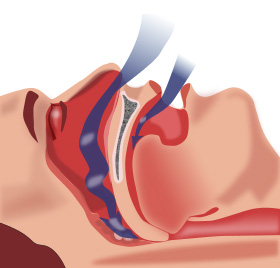Sleep apnea syndrome (OSAS) is a sleep disorder caused by obstruction, complete in the case of apnea or partial in that of hypopnea, of the upper airways. During the night’s rest, in fact, due to the position taken by the body there is a physiological reduction of the caliber of the airways and consequently breathing takes place with greater effort.  Snoring it is caused by the air which, passing faster (compared to when awake due to the reduction of the caliber just mentioned), causes the vibrations of the airways to vibrate: in these conditions the flow of air can be reduced by more than 50% (hypopnoeas) or stop, due to the obstruction that is created, for a few seconds (apneas).
Snoring it is caused by the air which, passing faster (compared to when awake due to the reduction of the caliber just mentioned), causes the vibrations of the airways to vibrate: in these conditions the flow of air can be reduced by more than 50% (hypopnoeas) or stop, due to the obstruction that is created, for a few seconds (apneas).
Normally this breathing disorder is more frequent in men and it accentuates with the progress of age; in obese patients with accumulations of fat in the neck, facial oval and with thickening of the soft tissue around the airways; among those who have a decreased muscle tone or structural and anatomical peculiarities that make the airways narrow.
The typical symptoms related to OSAS are varied: habitual and persistent snoring, breathing breaks of varying lengths during sleep, sudden awakenings caused by a feeling of suffocation (often in the patient’s unawareness), nocturia, xerostomia. Due to the occurrence of these conditions, the achievement of that deep and restful sleep, necessary to feel fully energized during the day, is definitely compromised.
The repercussions on the general health and quality of life are therefore inevitable and range from headache to excessive daytime sleepiness, from cognitive deficits (poor level of attention, concentration and memory disturbances) to irritability and continuous changes in mood, just to mention a few.
In the most serious forms of the syndrome, pathological evolutions can also occur at a systemic level, even very serious: arterial and pulmonary hypertension, ischemic heart disease, heart attack, cardiac arrhythmias and even strokes.
As regards the available therapeutic options, on the basis of the specific clinical picture manifested by the patient, obviously there is a tendency to prefer the implementation of minimally invasive treatments, thanks to which it is usually possible to resolve the symptomatology, referring only those patients to surgical therapies which, due to the seriousness of the disturbance, do not obtain a complete resolution of the problem.
Polysomnography is the instrumental procedure that allows you to accurately diagnose OSAS, the traces of which must always be analyzed by a doctor experienced in sleep disorders. On the basis of the severity of the clinical picture that emerges, the most appropriate therapeutic path is decided by practicing with the involvement of different specialist figures, each for the respective area of competence, including the dentist. In this regard, it should be stressed how important the dentist is to be able to intercept, through the check-ups that he periodically performs on the patients, the signs of the syndrome and give indications on the most appropriate treatment to follow: from ventilatory therapies (from carried out with special equipment during sleep) to the intraoral resin devices to be positioned on the arches, up to the surgical solutions.
In the developing age patient who has OSAS or habitual snoring, in general, the Orthodontic rapid expansion therapy of the palate has proven to be particularly appropriate for the purpose of functional improvement and resolution of the problem: this shows the decisive role played by the orthodontist in the interdisciplinary therapy of this breathing-related disorder.
















